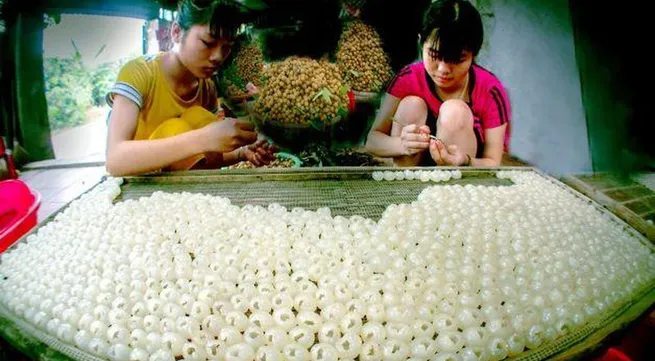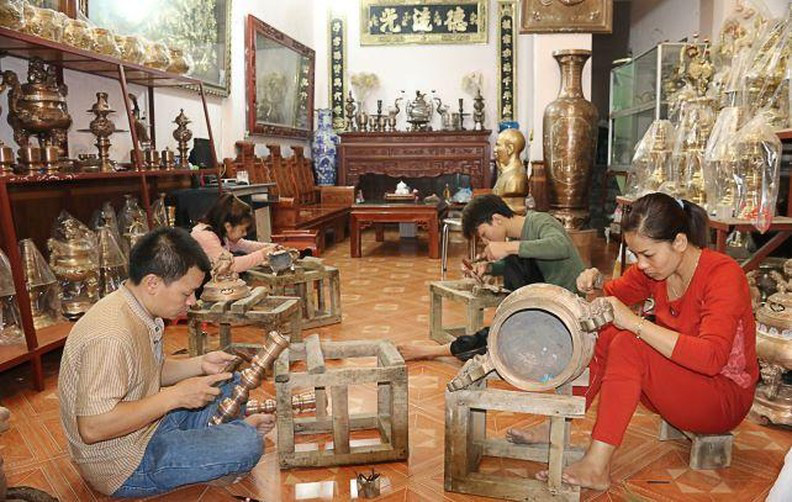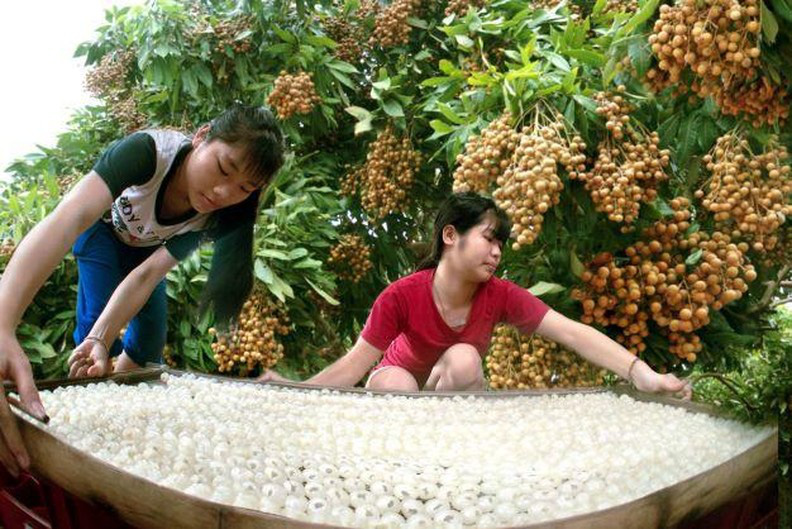Hung Yen interested in supporting the development of craft villages

According to the Rural Development Sub-Department of Hung Yen province, the province currently has 61 craft villages, including eight traditional craft villages and 43 craft villages recognised by the Provincial People’s Committee. The total number of production and business establishments in the craft villages is about 18,799.
A number of new craft villages such as flower and bonsai growing craft villages in Van Giang and Khoai Chau districts are growing and expanding. Many products of the craft villages are exported such as: carpentry, bronze, silver carving, bamboo and rattan products. Some local brands are well-known in the domestic market such as Hoa Phong wooden handicraft products originated in Hoa Phong commune, My Hao town; Thuy Lan civil carpentry originated in Thanh Long commune, Yen My district; Long Thuong bronze casting in Dai Dong commune, Van Lam district; and flowers and ornamental plants in Xuan Quan, Phung Cong, Me So, Thang Loi, Lien Nghia, and Van Giang districts.
Many traditional craft villages are operating stably and have the ability to develop more sustainable in the future that need to be maintained and preserved such as floriculture and ornamental plants in Van Giang and Khoai Chau districts; Thuy Lan furniture craft village, and Hoa Phong carpentry handicraft village. The annual revenue of production facilities in craft villages in Hung Yen province reaches over 7,700 billion VND, creating jobs for over 47,000 people.

Bronze casting in Long Thuong village, Dai Dong commune, Van Lam district, Hung Yen province
Production and business activities in craft villages have promoted the industrialisation of agriculture and rural areas in the province, shortening the gap between urban and rural areas, and reducing the poverty rate, contributing to restructuring agricultural and rural economy and building new-style rural areas. The average income for workers in rural craft villages is from 7 million VND per person per month, depending on types of occupations.
Thuy Lan carpentry village in Thanh Long commune, Yen My district has existed for about 100 years. This traditional craft village currently has about 150 households doing carpentry, creating jobs for about 500 local workers with an income of 9-15 million VND/person/month. Each year, craft villages supply tens of thousands of products of all kinds to the market, earning hundreds of billions of dong per year in revenue.
Thanh Long commune authorities have helped production households access preferential capital to create favourable conditions for Thuy Lan carpentry village to grow while promoting transport infrastructure to facilitate the travel between craft villages and other localities.
Nguyen Van Truong, the owner of Truong Nam furniture factory said that he has been in the field for many years. In recent years, he has invested in purchasing machinery and expanding production and business, so his factory produces thousands of wooden products each year with an annual revenue of 15-20 billion VND.
The whole province of Hung Yen has about 400 households engaged in the processing of dried longan flesh, concentrating mainly in Hung Yen city and districts of Phu Cu, Tien Lu, and An Thi. Longan flesh processing not only creates seasonal jobs for rural workers, but also helps reduce the pressure of consuming fresh longan, diversify products processed from longan, and improve the efficiency of longan cultivation.

Dried longan flesh processing in Hung Yen city, Hung Yen province
Truong Van Tuan, a resident in Thu Sy commune, Tien Lu district said that his family has been doing the longan flesh processing for about 27 years. In the longan harvest season, with three drying kilns and more than 30 workers, about 1 - 1.3 tonnes of fresh longan are processed per day, producing 1 - 1.5 quintals of dried longan flesh. Each kilogram of dried longan flesh earns a profit of 15,000 - 20,000 VND.
Director of Hung Yen Provincial Sub-Department of Rural Development, Le Van Thang, said that Hung Yen province pays much attention to supporting the development of craft villages and has issued many policies to encourage the development of craft villages, including financial support and creating favourable legal environment for establishments and households to expand their production scale.
Especially, the implementation of the OCOP programme has created a spillover effect, with the participation of many production facilities, helping perfect products and exploit the potential and human resources of the locality to make products meeting market demand.
Hung Yen province also supports the innovation of technological equipment and application of science and technology to production in order to improve the output, quality and competitiveness of products. The province also creates favourable condition for vocational training and improving the qualifications and management capacity of enterprises and production households in craft villages.
Hung Yen also mobilises all resources in terms of capital, land, science and technology to participate in the development of craft villages while promoting tourism in craft villages. In addition, much attention is paid to the prevention of environmental pollution in craft villages, boosting investment in infrastructure in craft villages and boosting trade promotion of craft products.
In the future, Hung Yen province will continue to develop policies to fuel the development of craft villages to produce products of high economic value, such as flowers, ornamental plants, and furniture. The province will also encourage the spread and development of traditional crafts to the surrounding areas and support the development of new products. At the same time, it is advisable to develop typical tourism products of handicraft villages associated with the OCOP model and traditional cultural values in order to bring into full play the advantages of traditional craft villages.





